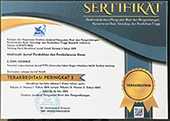Implementasi Model Reasoning and Problem Solving Berbantuan Lingkungan Sekitar dalam Pembelajaran IPA di Madrasah Ibtidaiyah
Abstract
Keywords
Full Text:
PDFReferences
Agung Herutomo, R., & Mulyono Saputro, T. E. (2014). Analisis Kesalahan Dan Miskonsepsi Siswa Kelas VIII Pada Materi Aljabar. Edusentris, Jurnal Ilmu Pendidikan Dan Pengajaran, 1(2), 134–145. https://doi.org/10.17509/edusentris.v1i2.140
Akbar, S. (2010). Penelitian Tindakan Kelas. Yogyakarta: Cipta Media Aksara.
Ashok Kumar Goel, M.S., M. S. (1989). Integration of Case-Based Reasoning and Model-Based Reasoning For Adaptive Desaign Problem Solving. Dessertation, 37–39.
Firma, E. (2015). Penerapan Model Pembelajaran Reasoning And Problem Solving Untuk Meningkatkan Kemampuan Scientific Reasoning Dan Pemecahan Masalah Fisika Siswa Sma Pada Materi Suhu Dan Kalor. Skripsi, 1–8. Retrieved from repository.upi.edu
Hernandez-Serrano, D. H. J. (2002). Case-based reasoning and instructional design: Using stories to support problem solving. Educational Technology Research and Development, 50(2), 65–77.
Jacqueline P. Leighton, R. J. S. (2012). Reasoning and Problem Solving. Experimental Psychology, 4(VIII).
Laksana, D. N. L. (2016). Miskonsepsi Dalam Materi Ipa Sekolah Dasar. JPI (Jurnal Pendidikan Indonesia), 5(2), 166–175. https://doi.org/10.23887/jpi-undiksha.v5i2.8588
Miles, Huberman, S. (2014). Qualitative Data Analysis. America: SAGE Publications.
Nurgiyantoro, B. (2005). Tahapan Perkembangan Anak Dan Pemilihan Bacaan Sastra Anak. Cakrawala Pendidikan, (2), 197–216. https://doi.org/10.21831/cp.v0i2.369
Philipp Sonnleitner, Ulrich Keller, Romain Martin, M. B. (2013). Students’ complex problem-solving abilities: Their structure and relations to reasoning ability and educational success. Intelligence, 41(5), 289–305.
Rahayu, P., Mulyani, S., & Miswadi, S. S. (2012). Pengembangan pembelajaran IPA terpadu dengan menggunakan model pembelajaran problem base melalui lesson study. Jurnal Pendidikan IPA Indonesia, 1(1), 63–70. https://doi.org/10.15294/jpii.v1i1.2015
Renny Nuri Septiani, Saptorini, S. H. S. (2012). MODEL PEMBELAJARAN REASONING AND PROBLEM SOLVING. Chemistry in Education, 2(2252), 56–61.
Romadhoni, F., Si, S. S. M., Sarwo, B., Kom, S. I., & M, M. (2017). Pola Komunikasi di Kalangan Pecandu Game Let ’ s Get Rich di Komunitas XLITE Tenggarong. EJournal Ilmu Komunikasi, 5(1), 235–247.
Salamah, U. (2018). PENERAPAN MODEL CHILDREN LEARNING IN SCIENCE (CLIS) TERHADAP PEMBENAHAN MISKONSEPSI IPA DI MI. The 3rd Annual International Conference on Is Lamic Education, 271–274. STIT NU AL-HIKMAH.
Sanjaya, W. (2006). Strategi Pembelajaran Berorientasi Standar Proses Pendidikan. Jakarta: Kencana Prenada Media Group.
Santyasa, I. W. (2007). Model-Model Pembelajaran Inovatif. Disajikan Dalam Pelatihan Tentang Penelitian Tindakan Kelas Bagi Guru-Guru SMP Dan SMA Di Nusa Penida, Tanggal 29 Juni s.d 1 Juli 2007 1, 1–16. https://doi.org/August 15, 2015
Setiyorini, N. D. (2018). Pembelajaran Kontekstual Ipa Melalui Outdoor Learning Di Sd Alam Ar-Ridho Semarang. Journal AL-MUDARRIS:Journal of Education, 1(1), 30–38. https://doi.org/10.32478/al-mudarris.v1i1.97
Suarsini, N. W., Tastra, I. D. K., & Suarjana, M. (2013). Pengaruh Model Pembelajaran Reasoning and Problem Solving Terhadap Hasil Belajar Matematika Siswa Kelas V SD di Gugus VIII Kecamatan Ubud. Ejournal Undiksha, 1.
Sutrisno, Leo, D. (2007). Pengembangan Pembelajaran IPA SD Unit 1. Malang: Depdiknas.
Widyaningrum, A. Z. (2016). EKSPERIMENTASI MODEL PEMBELAJARAN REASONING AND PROBLEM SOLVING DITUNJANG MEDIA POWER POINT. 2(1), 116–127.
Wiriatmadja, R. (2006). Metode Penelitian Tindakan Kelas. Jakarta: Remaja Rosdakarya.
DOI: https://doi.org/10.18860/mad.v11i2.7191
Copyright (c) 2019 Madrasah: Jurnal Pendidikan dan Pembelajaran Dasar

This work is licensed under a Creative Commons Attribution-NonCommercial-ShareAlike 4.0 International License.






